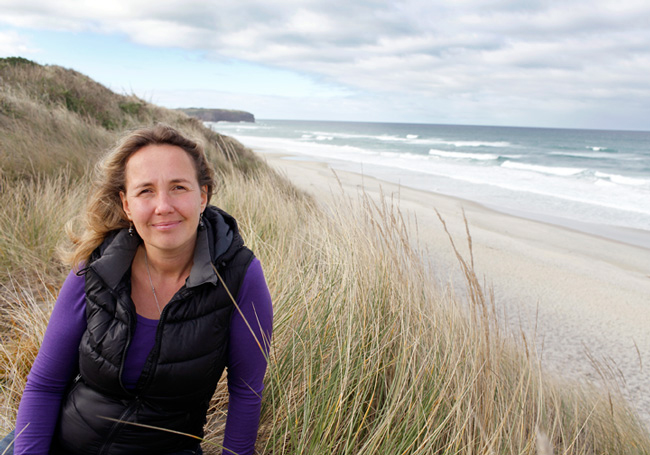
Economics Senior Lecturer Dr Viktoria Kahui. Photo: Sharron Bennett.
What do the European alpine meadows, the freshwater resources of Spain and the titi (mutton bird) of New Zealand's southern islands have in common?
All are common pool resources which either now or in the past have been subject to successful, long-term sustainable management organised by a local community that shared their bounty.
Driven by an interest in finding better ways to manage scarce resources, such as fishery stocks, Economics Senior Lecturer Dr Viktoria Kahui has taken the work of Nobel Prize winning economist Professor Elinor Ostrom, who looked at examples of communities that successfully managed common pool resources without government intervention, and compared it to pre-colonial Ngāi Tahu natural resource management. Co-authored by Amanda C. Richards, the resulting study has been published in Ecological Economics, under the title 'Lessons from resource management by indigenous Maori in New Zealand: Governing the ecosystems as a commons'.
"The idea is to examine what made these long-term ecosystem management systems successful and see what can they teach modern management."
Dr Kahui says, “The idea is to examine what made these long-term ecosystem management systems successful and see what can they teach modern management. Dr Jim Williams of Otago's Te Tumu (School of Maori, Pacific and Indigenous Studies) has a wealth of information about Ngāi Tahu life in the South Island, so we didn't have to go far to find the information.”
Professor Ostrom's work in common pool resources revealed that past examples of robust grass-roots management had certain things in common. Dr Kahui found that Ngāi Tahu's kaitiakitanga (stewardship) style of ecosystem management met all of Ostrom's criteria.
“One was well-defined boundaries, which Ngāi Tahu set with allocation of areas or resources to specific iwi, hapu and whanau. Another was having mechanisms in place where people could meet, discuss the resource restrictions and take part in low-cost conflict resolution; the Ngāi Tahu marae system fits this.
“A third criteria was restrictions pertaining to time, place, technology and quantity of resource units being harvested. Ngāi Tahu didn't have kumara in the South, so they were semi nomadic, moving to harvest eels, titi, etc. They applied a rahui (temporary reserve) on the titi islands during the birds' breeding season. There were also strict rules on the quantity, type of bird and method of harvesting (e.g. only chicks are taken to leave the breeding stock intact). Ngāi Tahu also placed an owhio or permanent reserve on places that needed protection; for example, not building on river banks to protect the banks and plants. They also used tapu (spiritual sanction) to manage resources.
“Ngāi Tahu used this adaptable toolkit, kaitiakitanga, according to what they thought would ensure the long term availability of the resource. It was a pragmatic way of ecosystem management with the overriding focus being on survival.”
Dr Kahui's believes Professor Ostrom's work and the lessons of kaitiakitanga both point to a need for devolution of responsibility, with government passing management of resources to local stakeholders, allowing those closest to the ecosystem to impose restrictions when they see a need.
“Right now, if you wanted restriction on, say, a cockle bed, it may take up to a year to go through government channels to do this. Locals can find this very frustrating.
“There is a huge amount of literature on ecosystem-based management systems, but I have yet to see one country implement it. The problem lies in its complexity. To manage a species you need to know its relationship with other species and its habitat.”
Dr Kahui says her initial work examining kaitiakitanga, and the published paper, are an almost philosophical starting point for looking at hands-on ecosystem-based management of common pool resources that can work without extensive scientific information.
“The criteria can be applied to any scarce resource. I am currently applying for funding to study high seas fishing, such as tuna fishing, applying Ostram's principles. No one owns the high seas, so Ostrom's ideas are perfect in this situation.”
